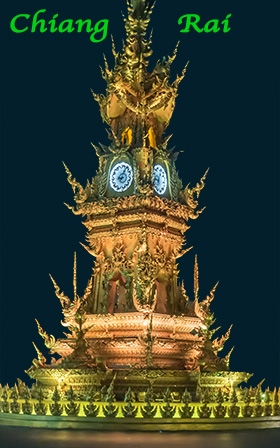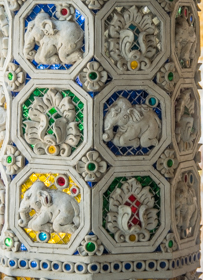

 |
With a population of 200,000 people Chiang Rai is the northern most major city in Thailand. It is easily reached by bus from Chiangmai. Within the city of Chiangrai I visited Wat Ming Muang, Wat Phrae Kuew, the Baan Dam Musuem (Black House) and Wat Rong Khun (White Temple). The White Temple, originally a normal Buddhist temple, as been reworked as a work of art. This was complemented by a visit to the border regions of Mae Sai and Sop Ruak. Sop Ruak is a small town on the Mekong River where Thailand, Myanmar and Laos intersect, the so-called Golden Triangle. |
I travelled to Chiang Rai from Chiang Mai by bus, but not the Green bus. When I went to the bus station I was approached by a tout who sold me a bus ticket. Instead of the direct route taking about four hours this bus did a milk run going vis Lampang and Phayao stopping regularly to let off and take on passengers. An old bus with limited top speed helped to stretch the travelling time out to eight to nine hours.
My hotel was very close to Chiang Rai's iconic clock tower. It was designed by Chalermchai Kossitpipat, the designer of the White Temple. Every night at 8pm and 9pm there is a brief sound and light display.

Wat Ming Muang was built in 1262 under the reign of King Mengrai.
It was buit in Lanna style by Queen Ta La Mae Sri as a memorial for the King's mother, Queen Chommuang. The King visited twice a year, once of the full moon night of Visaka, the second on Loi Krathong day. King Mengrai, who later established Chiang Mai, was the first Lanna king. The temple became prosporous due to dynasty patronage.
Originally named Wat Chang Moop - "Temple of the Crouching elephants", it was renamed Wat Ming Muang in 1970 when officially listed as a Buddhist temple. In the same year it gained a royal granting of land to build an ordination hall so that monks could conduct religious rites.
Covering an area of 160 thousand square meters, the Baan Dam Museum has over 40 structures. They are constructed of heavy dark wood and some resemble Buddhist temples.
Construction began in 1976 by Thawan Duchanee, a Thai artist. The main building, the art museum, was designed and built between 1999-2009. A large rectangular, single storied building, it is 20.3 metres wide, 44 metres long and 44 meters high.
Inside much of the art work, based on animal parts, is macabre. But many intricately carved wood lattices are also presented.
Wat Rong Khun was originally a traditional Buddhist temple in a poor state of repair. Restoration attempts were frustrated by a lack of money. Seeing its potential, local Thai artist Chalermchai decided to use his own money to redesign it as a work of art. He does not accept donations over ten thousand baht.
The ubosot is made of concrete with a wooden roof. It is white representing Buddhist purity. The dazzling whiteness is achieved with a blend of whitewash and transparent mirrored chips.
Leading to it, over a pond, is a bridge, the Gate of Heaven. At the bridges beginning is a pit with hundreds of skyward reaching hands, representing human suffering and hell.
The interior of the usobot is unadorned but does have a few murals of contempory figures. Photography was not allowed.
Around the grounds are several half human half bird statues. These are kinnairi which are considered to be benovolent.
Note the scaffolding on the usobot spire. On 5th May, 2014 at 18:08 (local time) the temple was hit by an earthquake. Initially the plan was to close the temple and demolish it for safety. But when engineers checked it they found that the structure was sound therefore the decision was made to restore it.
This was one of the few occassions I actually took a tour in Thailand. The main reason was transport as the sites visited are awkward to reach using public transport.
First stop of the day was Wat Tham Plaa, the so-called Fish Cave Temple.
To reach Wat Tham Plaa from Chiangrai, first drive approximatedly 52 km north along Phahonyothin Road and then turn west. Wat Tham Plaa is two kilomters from the highway. This is same Phahonyothin Road (Highway 1) that starts in Bangkok.
I did not care for the monkeys. I bought an ice-cream as was immediately attacked. This behavior comes from people feeding monkeys who then expect to be fed. I think humans feeding wild monkeys should be discouraged, or better still, banned. If their population declines due to a lack of food, so be it!
Our next stop was Wat Pra That Doi Wao at the end of Phahonyothin Road, in Mae Sai, on the border with Myanmar. This is also one of the favourite places to do visa runs, Mae Sai over the border to Tachileik, Myanmar.
Located on a lush mountainside oerlooking the Mae Sai River the temple was first supposely established by Phra Wao, the ruler of Naga Phan Yonok, in 179BC to house a relic (hair) of Lord Buddha. Wao supposely is Lanna for scorpion.
The temple has deteriorated and been rebuild many times over the centuries.
Since my visit a skywalk has been added. It should enhanced the viewing experience.
Leaving Mae Sai we head 9 kilometres eastwards to Sop Ruak on the Mekong. It is here where Thailand, Myanmar and Laos intersect, the so-called Golden Triangle. I say so-called because years ago the term applied to a triangular area in Myanmar's Shan state which at the time was the source of most of the world's illict heroin.
The foreground is Thailand, the left background, Myanmar and the right, Laos. Note the boats on the Mekong. Many boats travel to China.
A small museum in Sop Ruak is the House of Opium. It was a private collection of opium paraphernalia which was turned into a museum.
Now back in Chiangrai upon reflection I felt the tour though worthwhile was a little rushed. I think I could have spent a full day in both Mae Sai and Sop Ruak.
Wat Phra Kaew is the original home of the famed Emerald Buddha currently housed in Wat Phra Kaew in Bangkok. In 1434 the temples's octangonal chedi was struck by lightning revealing an internal stucco Buddha. Some of the stucco flaked off, revealing an internal green figure. Removing all the stucco revealed a small Buddha image made of semi-precious green stone. It bcame known as the Emerald Buddha.
In 1990 a similar but not exact replica of the Emerald Buddha was carved in China out of Canadian jade. The image was installed in a grand procession on 19th October, 1991.
Housed in the ubosoth is a large Buddha made of brass and copper, Phra Jao Lan Thong. Believed to be over 700 years old it has been housed in a number of wats and moved to Wat Phra Kaew in 1961.
I noticed in central and northern Thailand there a many dolls, outside of private buildings, in public parks, etc, I asked people if they had any religious signifance. The answer I got was ""No", they were decorative.
Leaving Chiang Rai, I returned to Chiang Mai, along the 165 kilometer route (highway 110), on an uneventual journey in the Green Bus